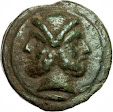AES “Money” from Republican Rome and Central Italy
EEM 12/2/15
The
story of the founding of Rome; April 21, 753 BC; is based on several oral
traditions that were put in writing centuries later. Roman scholar Marcus
Terentius Varro chose the date in the first century B.C.
Historians
say that a wave of immigrants entered Italy from Asia about 2000 BC and again
about 1000 BC. The second wave probably settled around Rome. Archeological
records say that central Italy around Rome was populated from the 1000 BC.
The
early Romans were primarily subsistence farmers. They did not have significant
wealth in the form of gold or silver and made transactions by barter. Early
fines were recorded in cows and sheep. In the fifth century, fines were
converted to bronze asses.
1
Cow = 100 Asses
1
Sheep = 10 Asses
1
As = 1 Roman pound of bronze, or
1
As = 330 grams = 11.6 ounces
Coins
were invented in the 7th century BC by the Kingdom of Lydia (now
western Turkey). They quickly spread to the independent city states of Ionia and
Greece (the Aegina turtle, the Athens owl, and others). Coins were used to
facilitate trade. It also made it easier to pay mercenary armies. See four examples
from Lydia, Ionia, Persia and Athens.
Roman
armies were drawn by family or clan. Only men who could afford to buy arms and
armor were drafted and allowed to fight. The richest could afford horses and
became the cavalry. When an army was needed soldiers left their farms, fought
for a short time and returned to their farms. Rome did not pay its armies until
405 BC during the ten year long siege on Vei. In 405BC Rome did not mint coins
and would have used barter (bronze by weight) or coins from Greece or Greek
colonies in Italy.
AES Rude are irregular shapes of bronze that were traded by weight.
In Latin, AES Rude = Rough Bronze. Some of the AES Rude are pieces broken from cast
plates or bars. Other pieces look like they were formed individually and have
irregular surfaces.
My wife asked how I know they are not just
rocks. I said, "faith in the supplier, looks and weight/SpGr.... and there
is no way to know for sure."
AES Formatum are bars with no features. They are normally identified in ratios of Roman pounds, or equivalent Asses.
Aes formatum,
VIII-IV cent BC, Artemide Aste, 2.5 asses
This lot has a piece of AES Formatum in the upper right corner. The others are pieces of AES Signatum and AES Grave, see below.
AES
Signatum are bars with features. Whole bars with
features are rare and expensive. A few examples are:
2 chickens / 2 tridents; Crawford 12/1; 270 BC
Sold by NAC in 2009 for $125M
Fragment of "ramo
secco" bar, 3rd cent BC
Sold by NAC in 2003 for $4M
Bull / Bull; Crawford 5/1;
270 BC
Andrew McCabe Collection
Pieces of Ramo Seco bars
AES Grave are cast bronze coins. They were based on an As of one
Roman pound of bronze. There were multiples and fractions:
X = Decussis = 10 Asses
V = Quincussis = 5 Asses
III = Tressis = 3 Asses
II = Dupindius = 2 Asses
I = As = 12 unciae = 300 oz. bronze
S = Semis = 6 unciae
4 dots = Triens = 4 unciae
3 dots = Quadrans = 3 unciae
2 dots = Sextans = 2 unciae
1 dot = Uncia
Sigma = Semiuncia, or less than uncia
Roman Republican.
Libral standard. Janus/Prow As, 225-217 B.C.
Obv.: Head of
Janus. Rev.: Prow right.
Crawford 35/1. TV
51.
AE (bronze); 258 gr;
63mm; gVF
Artemide Aste
Roman Republican. Post Semi Libral standard. Janus/Prow As, 215-212 B.C.
Obv.: Head of Janus. Rev.: Prow right.
Crawford 41/5a. TV .
AE (bronze); 71 gr; 39mm; XF
Artemide Aste
The small coins at the top left of the display
are a few Greek coins that predate Roman coinage.
From left to right is a chronological display
of AES or bronze “money” from Rome and Central Italy.
The Aes Rude shown here are from central
Italy. Some could be Roman at the time they were produced, but more likely were
areas outside of the original seven hills that made up the city of Rome. All of
these areas eventually became part of Rome. Some of the Aes Rude are broken
pieces of bronze. Larger broken pieces are grouped in the AES formatum and
signatum section in the middle surrounding a 746 gram cast bar = 2.5 Asses. Two
small pieces of Ramo Secco bar are to the right of the largest bar. Cast coins
are, from left to right, oldest to newest, and from top to bottom: As, Semis,
Triens, Quadrans, Sextans, Uncia and semi-uncia. The set are Crawford 35's, 225
to 217 BC. You can see the weight reduction due to a shortage of bronze in the
second Punic war in the As and Semis on the top right.
















